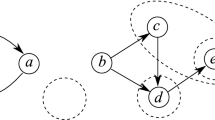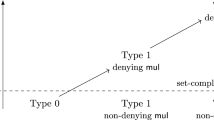Abstract
Second-order abstract categorial grammars (de Groote in Association for computational linguistics, 39th annual meeting and 10th conference of the European chapter, proceedings of the conference, pp. 148–155, 2001) and hyperedge replacement grammars (Bauderon and Courcelle in Math Syst Theory 20:83–127, 1987; Habel and Kreowski in STACS 87: 4th Annual symposium on theoretical aspects of computer science. Lecture notes in computer science, vol 247, Springer, Berlin, pp 207–219, 1987) are two natural ways of generalizing “context-free” grammar formalisms for string and tree languages. It is known that the string generating power of both formalisms is equivalent to (non-erasing) multiple context-free grammars (Seki et al. in Theor Comput Sci 88:191–229, 1991) or linear context-free rewriting systems (Weir in Characterizing mildly context-sensitive grammar formalisms, University of Pennsylvania, 1988). In this paper, we give a simple, direct proof of the fact that second-order ACGs are simulated by hyperedge replacement grammars, which implies that the string and tree generating power of the former is included in that of the latter. The normal form for tree-generating hyperedge replacement grammars given by Engelfriet and Maneth (Graph transformation. Lecture notes in computer science, vol 1764. Springer, Berlin, pp 15–29, 2000) can then be used to show that the tree generating power of second-order ACGs is exactly the same as that of hyperedge replacement grammars.
Similar content being viewed by others
References
Bauderon M., Courcelle B. (1987) Graph expressions and graph rewritings. Mathematical Systems Theory 20: 83–127
Comon, H., Dauchet, M., Gilleron, R., Jacquemard, F., Lugiez, D., Löding, C. et al. (2007). Tree automata techniques and applications. Available online at http://tata.gforge.inria.fr/.
Courcelle B. (1987) An axiomatic definition of context-free rewriting and its application to NLC graph grammars. Theoretical Computer Science 55: 141–181
de Groote, P. (2001). Towards abstract categorial grammars. In Association for computational linguistics, 39th annual meeting and 10th conference of the European chapter, proceedings of the conference (pp. 148–155).
de Groote P., Pogodalla S. (2004) On the expressive power of abstract categorial grammars: Representing context-free formalisms. Journal of Logic, Language and Information 13: 421–438
Drewes F., Kreowski H.-J., Habel A. (1997) Hyperedge replacement graph grammars. In: Rozenberg G. (eds) Handbook of graph grammars and computing by graph transformation. World Scientific, Singapore, pp 95–162
Engelfriet J. (1997) Context-free graph grammars. In: Rozenberg G., Salomaa A. (eds) Handbook of formal languages, Volume 3: Beyond words. Springer, Berlin, pp 125–213
Engelfriet J., Heyker L. (1991) The string generating power of context-free hypergraph grammars. Journal of Computer and System Sciences 43: 328–360
Engelfriet J., Maneth S. (2000) Tree languages generated by context-free graph grammars. In: Ehrig H. (eds) Graph Transformation. Lecture Notes in Computer Science, Vol. 1764. Springer, Berlin, pp 15–29
Engelfriet J., Schmidt E. M. (1977) IO and OI, Part I. The Journal of Computer and System Sciences 15: 328–353
Gécseg F., Steinby M. (1997) Tree languages. In: Rozenberg G., Salomaa A. (eds) Handbook of formal languages, Volume 3: Beyond words. Springer, Berlin, pp 1–68
Habel A. (1992) Hyperedge replacement: Grammars and languages. Springer, Berlin
Habel, A., & Kreowski, H.-J. (1987). Some structural aspects of hypergraph languages generated by hyperedge replacement. In G. Goos & J. Hartmanis (Eds.), STACS 87: 4th Annual symposium on theoretical aspects of computer science. Lecture notes in computer science (Vol. 247, pp. 207–219). Berlin: Springer.
Hindley J. R. (1997) Basic simple type theory. Cambridge University Press, Cambridge
Kanazawa, M. (2006). Abstract families of abstract categorial languages. In G. Mints and R. de Queiroz (Eds.), Proceedings of the 13th workshop on logic, language, information and computation (WoLLIC 2006). Electronic Notes in Theoretical Computer Science, 165, 65–80.
Kanazawa, M. (2007). Parsing and generation as Datalog queries. In Proceedings of the 45th annual meeting of the association for computational linguistics (pp. 176–183).
Kepser S., Mönnich U. (2006) Closure properties of linear context-free tree languages with an application to optimality theory. Theoretical Computer Science 354: 82–97
Lautemann C. (1990) The complexity of graph languages generated by hyperedge replacement. Acta Informatica 27: 399–421
Mints G. (2000) A short introduction to intuitionistic logic. Kluwer Academic/Plenum Publishers, New York
Raoult J. C. (1997) Rational tree relations. Bulletin of the Belgian Mathematical Society 4: 149–176
Rounds W. C. (1970) Mappings and grammars on trees. Mathematical Systems Theory 4: 257–287
Salvati, S. (2005). Problèmes de Filtrage et Problèmes d’analyse pour les Grammaires Catégorielles Abstraites. Doctoral thesis, Institut National Polytechnique de Lorraine.
Salvati S. (2007) Encoding second order string ACG with deterministic tree walking transducers. In: Wintner S. (eds) Proceedings of FG 2006: The 11th conference on Formal Grammar, FG Online Proceedings. CSLI Publications, Stanford, CA, pp 143–156
Seki H., Matsumura T., Fujii M., Kasami T. (1991) On multiple context-free grammars. Theoretical Computer Science 88: 191–229
Sørensen M. H., Urzyczyn P. (2006) Lectures on the Curry-Howard isomorphism. Elsevier, Amsterdam
Weir, D. J. (1988). Characterizing mildly context-sensitive grammar formalisms. Ph.D. dissertation, University of Pennsylvania.
Weir, D. (1992). Linear context-free rewriting systems and deterministic tree-walking transducers. In Proceedings of the 30th annual meeting of the association for computational linguistics (pp. 136–143).
Yoshinaka, R., & Kanazawa, M. (2005). The complexity and generative capacity of lexicalized abstract categorial grammars. In P. Blache, E. Stabler, J. Busquets, & R. Moot (Eds.), Logical aspects of computational linguistics: 5th international conference, LACL 2005. Lecture Notes in Computer Science (Vol. 3492, pp. 330–346). Berlin: Springer.
Author information
Authors and Affiliations
Corresponding author
Additional information
This work was supported by the Japan Society for the Promotion of Science under the Grant-in-Aid for Scientific Research (18-06739).
Rights and permissions
About this article
Cite this article
Kanazawa, M. Second-Order Abstract Categorial Grammars as Hyperedge Replacement Grammars. J of Log Lang and Inf 19, 137–161 (2010). https://doi.org/10.1007/s10849-009-9109-6
Published:
Issue Date:
DOI: https://doi.org/10.1007/s10849-009-9109-6




